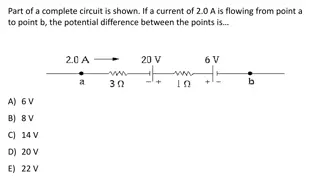Electrical and Circuits 1
Electric charge, insulators, conductors, and electrical flow through materials. Understand static electricity and examples of static charge uses. Discover the concept of insulators with analogies and examples.
Download Presentation

Please find below an Image/Link to download the presentation.
The content on the website is provided AS IS for your information and personal use only. It may not be sold, licensed, or shared on other websites without obtaining consent from the author. Download presentation by click this link. If you encounter any issues during the download, it is possible that the publisher has removed the file from their server.
E N D
Presentation Transcript
Course 05 Electrical and Circuits 1 Module 1: Introduce the concept of electric charge, insulators and conductors
Topics Electric charge Insulators Conductors Electrical flow through material
Relevancy Understanding the basics of electricity To promote an engineering mindset
Static Electricity Electric charge that has accumulated on an object. Static electricity is often created when two objects that are not good electrical conductors are rubbed together, and electrons from one of the objects rub off onto the other. This happens, for example, when combing one's hair or taking off a sweater. Sudden releases of built-up static electricity can take the form of an electric arc. (Dictionary.com, 2022)
Examples of Static Charge and Uses CRT television screen Lightning Clothes dryer Electrostatic paint sprayer Pollution management Water ionization
What is an Insulator A material or an object that does not easily allow heat, electricity, light, or sound to pass through it. Air, cloth and rubber are good electrical insulators; feathers and wool make good thermal insulators. (Dictionary.com, 2022)
Insulator Analogy When compared to water, insulators would be the obstructions that block the flow of water. When compared to light, insulators would be similar to opaque windows or blackout curtains, where light cannot penetrate into a space
Insulator (Moore, 2019)
Examples Glass Mica Rubber Fibreglass Ceramic Dry wood Plastic Pure water
Can you think of any other insulators?
What is a Conductor A material or an object that conducts heat, electricity, light, or sound. Electrical conductors contain electric charges (usually electrons) that are relatively free to move through the material; a voltage applied across the conductor therefore creates an electric current. Insulators (electrical nonconductors) contain no charges that move when subject to a voltage. (Dictionary.com, 2022)
Conductor Analogy When compared to water, conductors would be the pipes that allow the flow of water. When compared to light, conductors would be similar to clear glass windows or the absence of curtains. This allows light to penetrate into a space
Conductor (Alistair1978, 2020)
Examples Copper Aluminum Silver Iron Steel Gold Dirty water
Can you think of any other conductors?
Wires and Cables A cable is a multi-wire conductor A wire is a single conductor Wire conductors may be stranded or solid Insulation sheathing mainly polyvinyl chloride (PVC) or polyethylene (PE)
Stranded vs Solid Wire (Ehardt, 2005) (Tester101, 2012)
Conductor (Wire) Size Conductor size is measured in both gauge number (AWG) or in mils Diameter of a conductor can be measured in American Wire Gauge (AWG) Smaller numbers = larger wire size Metric Measurement of cross-sectional area of wire (mm2) Circular Mils (cmil) Measurement of cross-sectional area of wire (1/1000thof an inch) Thousands of circular mils (MCMs) Used for large diameter wire measurements
Wire size (Powerfox, 2019)
Ampacity Measurement of the maximum current a wire can allow Depending on the current load, wire may need to be derated Derating a wire is reducing the maximum ampacity of a wire
Derating To lower the rated capability of (something, such as an electrical or mechanical apparatus) because of deterioration or inadequacy (Merriam-Webster, n.d.)
Derating Factors Temperature Hotter ambient temperature means the cable can carry less current Ground temperature derates more than air temperature Insulation rating The higher the insulation rating, the more current a wire can carry Load factor (LF) More heat is generated for a higher load factor
Derating Factors Ground terminal resistance More thermal resistance from the environment increases heat in cable Underground laying depth Buried cables have a design depth; if not met, will require derating. Cable configuration Cables in close proximity cannot shed the temperature load
Calculating Derating Factors For each factor that must be applied, it is multiplied together Multiply the resulting factor to the ampacity of the wire If the adjusted value is less than the use case, a larger conductor must be used

























